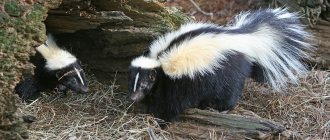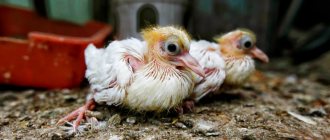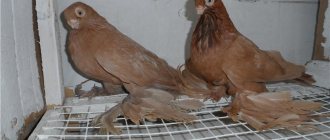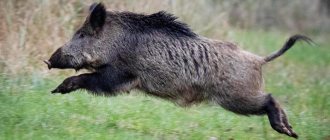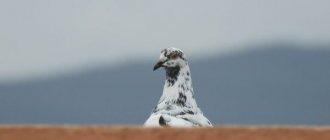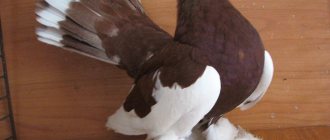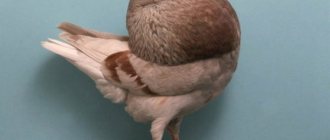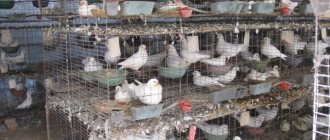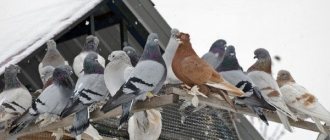In order to carry out breeding work and artificially create bird pairs, the breeder must be able to correctly determine the sex of an individual. It is impossible to distinguish a dove from a dove based on primary sexual characteristics, so you have to compare birds by analyzing their appearance, voice, body structure and even behavior. In addition to modern scientific methods, you can also use folk methods.
Main differences in the body structure of pigeons
For the breeder, this information is very valuable, since by designating the desired sex, you can directly influence the reproductive capabilities of the pigeon family.
There are several ways to determine the sex of pigeons. Each person prefers to use their own methods. The main characteristics that breeders rely on to distinguish between girls and boys are their habits, body structure, sounds made, etc.
In order to determine the sex of a pigeon with the highest probability, it is best to study the structural features of the pelvis of this bird. The hip part has characteristic differences in structure.
- Pigeons have two bones below the chest, closer to the tail. Their placement determines their gender.
- In the boy pigeon, these bones are located almost next to each other. An exception is possible only in case of rickets. The lack of calcium makes the male's pelvis quite wide.
- The dove has a gap of up to a centimeter between the bones. A female that has already laid eggs has a narrow pelvis. This feature also needs to be taken into account.
To identify signs of the structure of the pelvis, the bird must be picked up and calmed. Gently stroke the belly area, moving towards the tail. You will clearly feel the two pelvic bones.
Dove or dove?
If you compare the appearance of pigeons from the side, you will notice characteristic differences in the head and beak of boys and girls . The boy's pigeon has a much wider neck and a more impressive frontal part. The beak has a curved shape. The girl's dove has a more delicate and graceful neck. The beak is visually narrower, with neat cere. At the same time, the eyes are more striking and protruding.
Some breeders pay attention to the bird's reaction when its beak is touched. The male in this case shows great anxiety. The female reacts to touch much calmer. This sign is not reliable enough, since it may indicate, first of all, character traits, and only then gender.
Flight
These pigeons are easy to train and can fly for a long time without getting tired. Some of them were once used as post offices. Flight includes:
- Nikolaevskaya breed. These birds differ in their flight style - they fly vertically in a straight line and rise very high. They have a strong body and a small neck.
- Berlin short-billed tumbler. It is small in size and has a short beak, a very convex forehead, and wings hanging below the tail. The breed is very numerous. They have a plain or variegated color.
- German monk. They do not fly very high; during the flight they attract other birds. At the back of the head they have a hood made of feathers.
- Berlin long-billed. A very rare species. It has an unusual appearance - a vertical position of the neck and a horizontal position of the head, which is very narrow, and also has a thin beak.
Peculiarities in the habits of pigeons during the mating season: the difference between a pigeon and a dove
Quite often we see pigeons flirting with each other. The behavior of birds during the mating season makes it easy to identify a girl and a boy.
- The main courtship is assigned to the male. His persistent behavior is accompanied by outstretched wings and tail, fluffed feathers. The pigeon actively pursues the female, trying to jump on her.
- If the female is friendly, she will reciprocate the feelings of the pigeon. She nods and bows to the dove, accompanying her actions with cooing sounds. Spreads plumage along the lower back.
- When going to meet the male, the dove bends, sticking out the back of her body. It is in this behavior that one can find the difference between a dove and a dove.
The mating season for pigeons occurs in the spring months, so this method is not always convenient to use.
Exterior
It is possible to determine the sex of a bird by its exterior, but this seems possible only at 1.5-2 months. At this time, the chicks finish molting. They are covered with adult feathers. All parts of the body become more shaped:
- the male is always larger than the female. The pigeon's head is larger, its beak is more powerful, and its neck is wider. The chest and back are more massive. The dove always looks more elegant. Her head is slightly elongated, her neck is elongated, her body is toned;
- In females, the position of the legs is wider than in males. Their landing is more horizontal, they hold their head slightly at an angle to the ground;
- The pigeon's plumage is brighter and more saturated than that of the dove. It becomes especially bright during the mating season. Males are looking for a mate. They appear before the dove in all their glory. Dove, on the contrary, is modest and calm. Its color is not very bright. All colors are a little washed out;
Pigeon (male)
- The plumage is analyzed based on the name of the breed. Thurmans are distinguished by their red color and the belt on the tail: it is formed by white wide feathers. Males have a more expressive belt than females, especially when they fan it out;
- Texans are an autosex breed. The sex of the chicks is immediately visible. It is determined by the length of body down. Girls have longer and thicker down than boys. Spots are visible on the surface of the child's beak. In females they can be brown or dark. In males, the beak has an even gray tint;
- By the color of the texans, you can determine the sex of the already fledged young. In females, the color of the coat is always dark with rare light spots. Males are light-colored with a marbled pattern of black stripes.
Igor Nikolaev
auto RU
Experts say that the color of plumage is inherited by the chicks. If the mother has a yellow or red color, the daughters will acquire the same feather color. The sons will inherit their father's plumage. If there is a need to mark birds by gender, removable rings are used. It is too late to put on fixed ones for young animals that have already fledged.
More on the topic: What kind of care does a pouting pigeon require?
The color of a dove and a dove: what is the difference?
There are more than several hundred species of pigeons. Despite this abundance, the plumage of females and males has visual differences. Regardless of the breed, the color of the feathers of a dove is in most cases much darker than that of a pigeon. The color scheme of feathers is inherited by offspring.
Color difference
- For the dove, color performs a protective function in nature, since she has to hatch eggs.
- Males, on the other hand, are endowed with more beautiful colors in the wing area and multi-colored shine in the neck area. Such features help to attract the attention of the dove.
Identifying Chicks
It is much more difficult to distinguish the sex of small birds. Young pigeons have much less difference in appearance than adult pigeons. The dove does not differ from the young dove in voice and behavior. And the pelvic bones are structured the same. But experienced breeders recognize birds by certain signs. Boys have a larger head, a wider and more massive nose. The small pigeons are approximately the same in size. To more accurately recognize the gender of adolescents, it is advisable to know what breed the kids belong to. You need to take a close look at their appearance and observe their habits.
When studying pigeons, professional poultry keepers analyze all indicators in a comprehensive manner. This tells them how to identify the sex of these beautiful birds with maximum accuracy.
Studying the methods of sexual differentiation of birds is extremely important for recording a flock, creating pigeon families, and reproducing offspring. Helps identify their hormonal and genetic characteristics
To learn how to distinguish a pigeon from a dove with 99% accuracy, see the following video.
How to determine the gender of a pigeon by its voice?
The cooing of pigeons has characteristic differences.
- Males sound more confident and loud. The voice is their integral attribute for attracting the attention of the dove.
- Females make more muffled guttural sounds. If you listen carefully, you will notice a special burr.
Determining the sex of pigeons based only on vocal data is quite risky. This feature should be tested in conjunction with other methods.
Useful tips
Recommendations to help you correctly distinguish doves from their partners:
- Several proven methods are used.
- They understand that even 2-3 methods sometimes lead to errors. They don’t fully hope, they analyze. They take into account breed, age, etc.
- Birds sometimes behave unusually. For example, doves are too active, and males are indecisive. The reasons most often lie in hormonal imbalances. In addition, conditions and health status influence. Less often, these are the characteristics of a particular bird, its character.
When breeding, the sex must be determined, as this is necessary to obtain pairs.
Individuals with health problems, for example, hormonal ones, are “taken for a pencil”. Then they are treated or not allowed to reproduce. It can be difficult for a beginner to distinguish a dove from a male. However, after training it works in most cases. To more accurately determine gender, you need to check at least 2-3 characteristics.
Character of pigeons: the difference between a dove and a dove
In addition to differences in appearance, nature has endowed doves and doves with opposite characters.
- Males exhibit more warlike behavior. They quite often get into fights over a female representative. While courting the dove, they occupy a certain territory and meet any competition with hostility. Some males, realizing their weakness in front of their opponent, evasively give in, avoiding a squabble.
- It should be noted that females do not always respond favorably to courtship. If the dove already has a mate, then the male will face a decisive refusal. Females are very devoted to their family.
- You can analyze the behavior of pigeons by placing them in a confined space. This method is quite popular in places where pigeons are sold and at bird shows.
By nature,
the relationship between two females looks like a complete lack of interest, or the same type of cooing. You can always expect an unpredictable reaction from birds, so support your assumptions with several arguments.
Distinctive characteristics table
Since the signs by which experienced breeders distinguish between pigeons of different sexes can hardly be called unambiguous, it is advisable for beginners to determine whether a bird is male or female by several characteristics. For convenience, they are presented in the table.
| Sign | Male | Female |
| Size | Quite large, with a massive body | Compared to a dove it seems miniature |
| Color | Iridescent feathers on the neck, splashes of bright colors, unusual patterns on the tail and wings | Feathers are inconspicuous, plain |
| Head | With a high, massive beak, and rough wax. “Sits” on a wide and short neck. Eyes are round and large | Rounded, without irregularities, with a small beak, small cere and expressive eyes |
| Voice | Loud, often aggressive | Quiet cooing, which has been compared to French patois |
| Attitude towards members of the same sex | Strives for leadership, seizing someone else's territory and preserving its own territory, often fights | In most cases, peaceful |
| Attitudes towards individuals of the other sex | Courtes, seeks to attract attention, hugs the female with his wing | If she likes her partner, she squats on her tail and coos, otherwise she is aggressive |
The use of these techniques together will allow you to determine as accurately as possible who is who: male or female. The main thing is to use different approaches, and not stop at one sign.
Determining the sex of pigeons using the folk method
Despite the dubiousness of one of the folk methods, all breeders are familiar with it. A simple technical experiment deserves attention.
- You need to build a pendulum from a piece of copper and a thread. A coin can serve as a pendant. The length of the thread or fishing line should be no more than half a meter.
- The bird that needs to be sexed is placed in one hand. You need to take the pendulum in your other hand and place it above the pigeon’s back. Each floor corresponds to a special pendulum movement.
- Rotation of the pendant in a circle characterizes the dove, swaying from side to side along the body corresponds to the dove.
Folk method
Breeders also analyze the behavior of birds when in contact with humans. When choosing a bird, try patting it on the breast while clasping its two wings with one hand. Tucked paws are more characteristic of the male gender.
When determining sex, age and breed are of no small importance. In rare species of pigeons, girls and boys have very similar characteristics. Each method of determining sex has its own disadvantages, so conclusions must be drawn based on several features.
